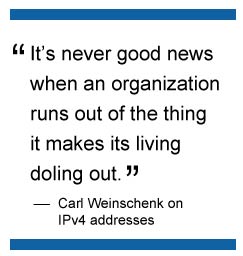The long slog to adoption of Internet Protocol version 6 (IPv6) passed a significant milestone last month when the American Registry for Internet Numbers (ARIN) – the organization charged with managing Internet addresses in the United States, Canada, the Caribbean and Atlantic islands — ran out of IPv4 addresses to distribute. ARIN joined Regional Internet Registries covering most of the rest of the world in IPv4 exhaustion.
While important, the official exhaustion of IPv4 addresses doesn’t change the fundamentals of where the industry is. The key point is that the transition to IPv6, an issue often presented as a hard and fast switchover rather than the gradual evolution that it really is, will be with us for a long time.

It’s never good news when an organization runs out of the thing it makes its living doling out. What takes the edge off is that IPv4 addresses are available from other sources and technical workarounds can make the current store of IPv4 addresses be stretched like the last quart of water in a canteen. In any case, the idea is to move from IPv4 to IPv6, so the exhaustion of the antiquated addressing system can be seen as part of the natural evolution and a not-so-gentle push to the laggards to get with the program.
More than Symbolic
The exhaustion is more than a symbolic motivational tool, however. IPv4 Market Group President Sandra Brown suggested in response to emailed questions that exhaustion means that companies need to face the future, even if they don’t want to. The fact that ARIN has no IPv4 addresses left is “[v]ery important in terms of pushing up the cost of IPv4. Now that ‘v4’ is no longer free, if you need a solution you are somewhat more likely to consider dual stack.”
The dual-stack approach is seen by experts as the most efficient and seamless way for the industry to migrate from IPv4 to IPv6. As the name implies, dual stack simply runs IPv4 and IPv6 in parallel, with a particular packet taking the path that its address requires. In addition to dual stack, workarounds include tunneling IPv6 through IPv4 networks and carrier grade network address translation (CGN), in which one public IP address is parlayed into many private addresses on networks that are in some way cordoned off from the broader Internet.
The other important ramification of the official exhaustion of IPv4 addresses is that the aftermarket becomes vital. Companies that need IPv4 can get them, though only from organizations that are holding them but not using them. Indeed, the ground rules for doing that are being worked out by industry bodies, such as the North American Network Operator’s Group (NANOG), which took up the matter at a meeting during the first week of October in Montreal.
IPv6 progress has been deliberate. Paul Nicholson, the director of product marketing for A10 Networks, said that there has been a steady proportional increase in IPv6-based traffic during the last year. However, traffic hasn’t exploded. For instance, Google’s IPv6 still is less than 10 percent of the company’s overall traffic.
A Long Transition, Without Deadlines
Decision makers understand, at the conceptual level, that IPv6 is important. There are some good reasons that the IPv6 drama has had such a long run, however. One is simply the sheer magnitude of the task of changing from one addressing scheme to the next. It also lacks a definitive deadline by which the switch must be made. If an organization doesn’t implement IPv6, it won’t go off line. The impact will be a more subtle constriction of services. That won’t make users happy, but it isn’t as dire as going out of business.
Finally, no immediate and direct financial benefit to the deployment of IPv6 exists. It is only a future enabler. The involved – and not inexpensive — nature of the changeover and the lack of immediate payback may tend to get it pushed down on the priority list.
At this point, the real work is the continual and systematic implementation of IPv6. In many cases, progress is good.
“Service providers — many of which have been planning the transition for many, many years — are using IPv6, and it seems to be going quite well,” John Curran, president and CEO of ARIN, said.
But progress is not uniform. The content, the network and the end-user equipment must be IPv6-enabled. Among the things that remain to be done, according to Koat, are further testing and trials of both dual-stack and IPv6-only approaches. Brown writes that an important task that needs attention is IPv6-enabling cloud-based applications.
The bottom line is that the exhaustion of ARIN’s IPv4 addresses doesn’t materially change anything. It is a sign, however, that organizations and service providers who have been sitting on their heels must get busy. “They need to have a strategy in place,” Nicholson said. “If they do nothing [now], they will have an expensive fire drill sometime in the future.”
Carl Weinschenk covers telecom for IT Business Edge. He writes about wireless technology, disaster recovery/business continuity, cellular services, the Internet of Things, machine-to-machine communications and other emerging technologies and platforms. He also covers net neutrality and related regulatory issues. Weinschenk has written about the phone companies, cable operators and related companies for decades and is senior editor of Broadband Technology Report. He can be reached at [email protected] and via twitter at @DailyMusicBrk.


